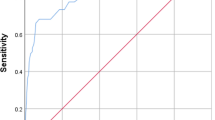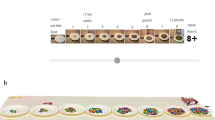Abstract
Objective:
The aim of this report was to present methodological aspects of assessing the effects of advertising on children's food choices and preferences.
Methods:
Two instruments have been used: first, a choice experiment on children's food knowledge and preferences, and second, a questionnaire on children's knowledge about and attitudes towards advertising. The choice experiment employed 10 matched pairs of food items, each represented in two magazines, one that tested knowledge and the other food preferences. The children's questionnaire contained four dimensions that tested children's credibility and suspiciousness of, as well as entertainment by, advertising. Although based on already developed tools, both instruments were modified to suit the young target group and ensure cross-cultural comparability. The questionnaire was validated via Cronbach's alpha and factor analysis.
Subjects:
A total of 393 children aged 5–11 years from seven European countries participated in the study.
Results:
Both instruments proved to be valid and reliable to analyse the food knowledge and preferences of children, as well as knowledge about and attitudes towards advertising. While 92.2% of the children predominantly recognised the healthier food, only 33.2% also preferred the healthier food. The Cronbach's alpha values for the dimensions were 0.470 for credibility, 0.409 for suspiciousness and 0.295 for entertainment factor. The gathered data revealed that children are rather critical and suspicious of advertising and only moderately entertained.
Conclusion:
Both instruments are applicable for the 5- to 11-year-old age group in different European countries. Descriptive results indicate additional insights into the effects of advertising on children's food knowledge, preferences and food choice.
This is a preview of subscription content, access via your institution
Access options
Subscribe to this journal
Receive 12 print issues and online access
$259.00 per year
only $21.58 per issue
Buy this article
- Purchase on Springer Link
- Instant access to full article PDF
Prices may be subject to local taxes which are calculated during checkout
Similar content being viewed by others
References
Robinson TN, Borzekowski DLG, Matheson DM, Kraemer HC . Effects of fast food branding on young children's taste preferences. Arch Pediatr Adolesc Med 2007; 161/8: 792–797.
Ekström KM, Tufte B . Introduction. In: Eckstrøm KM, Tufte B (eds). Children, Media and Consumption—On the Front Edge. Nordicum; Gothenborg, 2007, pp 11–30.
Story M, French S . Food advertising and marketing directed at children and adolescents in the US. Int J Behav Nutr Phys Act 2004; 1/1: 3.
Stead M, McDermott L, Hastings G . Towards evidence-based marketing: the case of childhood obesity. Market Theor 2007; 7/4: 379–406.
Desrochers DM, Holt DJ . Children's exposure to television advertising: implications for childhood obesity. J Public Policy Mark 2007; 26/2: 182–201.
Hastings GM, Stead L, McDermott A, Forsyth A, MacKintosh M, Rayner C et al. Review of the Research on the Effects of Food Promotion to children. Report for the Food Standard Agency, Centre for Social Marketing: Glasgow, 2003.
Kelly B, Smith B, King L, Flood V, Bauman A . Television food advertising to children: the extent and nature of exposure. Public Health Nutr 2007; 10/11: 1234–1240.
Taveras EM, Sandora TJ, Shih M-C, Ross-Degnan D, Goldmann DA, Gillman MW . The association of television and video viewing with fast food intake by preschool-age children. Obesity 2006; 14/11: 2034–2041.
Halford JCG, Boyland EJ, Cooper GD, Dovey TM, Smith CJ, Williams N et al. 2008). Children's food preferences: effects of weight status, food type, branding and television food advertisements (commercials). Int J Pediatr Obes 2008; 3/1: 31–38.
Ahrens W, Bammann K, de Henauw S, Halford J, Palou A, Pigeot I et al. Understanding and preventing childhood obesity and related disorders—IDEFICS: a European multilevel epidemiological approach. Nutr Metab Cardiovasc Dis 2006; 16/4: 302–308.
Calfas KJ, Sallis JF, Nader PR . The development of scales to measure knowledge and preference behavior in 4- to 8-year-old children. J Dev Behav Pediatr 1991; 12/3: 185–190.
Kopelman CA, Roberts LM, Adab P . Advertising of food to children: is brand logo recognition related to their food knowledge, eating behaviours and food preferences? J Public Health 2007; 29/4: 358–367.
Diehl JM . Macht Werbung Dick? Einfluss der Lebensmittelwerbung auf Kinder und Jugendliche. Ernährungs-Umschau 2005; 52: 40–46.
Baxter SD, Smith AF, Litaker MS, Baglio ML, Guinn CH, Shaffer NM . Children's social desirability and dietary reports. J Nutr Educ Behav 2004; 36/2: 84–89.
Pecheux C, Derbaix C . Children and attitude toward the brand: a new measurement scale. J Advert Res 1999; 39/4: 19–27.
Mazzocchi M . Statistics for Marketing and Consumer Research. Sage Publications: London, UK, 2008.
Kim J-O, Mueller CW . Introduction to Factor Analysis—What It Is and How To Do It. Sage University Paper Series on Quantitative Applications in the Social Sciences, 07-013, Sage Publications: Newbury Park, CA, 1978.
Acknowledgements
This work was done as part of the IDEFICS study (http://www.idefics.eu). We gratefully acknowledge the financial support of the European Community within the Sixth RTD Framework Programme Contract No. 016181 (FOOD) and the funding from EU DG Research for the IDEFICS study. We gratefully acknowledge the development of the parent–child instrument by Jessica Dreas from the Bremen Institute for Prevention Research and Social Medicine (BIPS), Germany, in collaboration with Eva Ossiansson and Barbro Johansson from the Gothenburg Research Institute at the University of Gothenburg, Sweden. The ethnographic studies have been developed by Eva Ossiansson and Barbro Johansson from the Gothenburg Research Institute at the University of Gothenburg, Sweden. We are particularly thankful for the feedback received from the field teams in the participating IDEFICS countries, which helped us to develop and improve the instruments. We also thank the German AID Infodienst for permission to use their food cards. Finally, we thank the children, parents and staff of the co-operating school in Denmark (St Petri Dansk-Tysk Skole in Copenhagen) and all children and parents participating in the IDEFICS study.
The information in this document reflects the author's view and is provided as is.
Author information
Authors and Affiliations
Consortia
Corresponding author
Ethics declarations
Competing interests
The authors declare no conflict of interest.
Additional information
Statement of ethics
We certify that all applicable institutional and governmental regulations regarding the ethical use of human volunteers were followed during this research. Approval by the appropriate ethical committees was obtained by each of the eight centres engaged in the fieldwork. Participants were not subjected to any study procedure before both the children and their parents gave their consent for examinations, collection of samples, subsequent analysis and storage of personal data and collected samples. The participating children and their parents could consent to single components of the study while refraining from others.
Rights and permissions
About this article
Cite this article
Gwozdz, W., Reisch, L. & on behalf of the IDEFICS Consortium. Instruments for analysing the influence of advertising on children's food choices. Int J Obes 35 (Suppl 1), S137–S143 (2011). https://doi.org/10.1038/ijo.2011.46
Published:
Issue Date:
DOI: https://doi.org/10.1038/ijo.2011.46
Keywords
This article is cited by
-
Healthy Choice?: Exploring How Children Evaluate the Healthfulness of Packaged Foods
Canadian Journal of Public Health (2012)
-
Five-minutes-to-twelve for implementation of early changes in dietary and lifestyle behaviour across Europe
International Journal of Obesity (2011)
-
The IDEFICS cohort: design, characteristics and participation in the baseline survey
International Journal of Obesity (2011)



